Kate Rauner's Blog, page 66
December 28, 2016
Limusaurus Mud Lizard Needs Dentures #poem #poetry #dinosaur #nature #fossil
I’d peck your kneecaps off – if I wasn’t dead for 160 million years
As dinosaurs evolved to birds
Their teeth reduced and disappeared,
Though some kept jaw bones jagged sharp –
A modern goose is to be feared!
Teeth seem to be so useful
To hunting and to dine
That penguins have a toothed tongue,
Some modern chicks boast oral spines.
One hundred million years ago
Limusaurs did not concur.
They dropped their teeth in adult days,
A smooth beak they preferred.
Wholly unexpected
And never seen before,
Fossils show that babies grew
And lost their teeth that tore.
More strange discoveries await
As fossils come to hand
To show us that surprising beasts
Once stalked across the land.
by Kate Rauner
Thanks to sciencemag.org for this news.
[image error]All my books, including collections of my science-inspired poetry, are available at Amazon, Barnes & Noble, iTunes, Kobo, and other major online retailers. You’ll also find paperbacks at Create Space and all major digital formats at Smashwords. Read one today.
Filed under: Poetry Tagged: bird, dinosaur, evoloution, fossil, Limusaurus, nature, poem, poetry, teeth








December 24, 2016
Happy Christmas #merrychristmas #happyholidays #xmas #hannukah #HappyHannukah #Kwanzaa #HappyKwanzaa
Favorite ornaments
The holiday season is in full flower. Solstice is behind us and I enjoyed walking a friend’s labyrinth at her party. It’s Christmas Eve, Hanukkah starts tonight, Kwanzaa in two days, and other winter festivals you might enjoy: Saint Nicholas Day (Christian), Fiesta of Our Lady of Guadalupe (Mexican), St. Lucia Day (Swedish), Hanukkah (Jewish), Christmas Day (Christian), Three Kings Day/Epiphany (Christian), Boxing Day (Australian, Canadian, English, Irish), Omisoka (Japanese), Yule (Pagan), Saturnalia (Pagan). I wonder which holidays will follow colonists into space?
Personally, I’m a totally lapsed Catholic who still enjoys the traditions of my youth – I have one live Xmas tree and two artificial trees in my home. The cats are finally old enough (mature enough?) to refrain from knocking them over.
December 21, 2016
Happy Solstice – Winter in North, Summer in South, #holiday on Earth #solstice #Merrychristmas
Walking the labyrinth at Chartres Cathedral
Thanks to the tilt of Earth’s axis, we’re about to mark the Perihelion Solstice, the shortest day and the longest night of the year in the northern hemisphere, or longest day and shortest night in the southern.
Earth will be closest to the Sun, at its orbital perihelion, about two weeks after the December Solstice. The close timing is a coincidence, an artifact of our eccentric orbit.
In 1246, the December Solstice was on the same day as the Earth reached its Perihelion. Since then, the Perihelion and Aphelion dates have drifted by a day every 58 years. In the short-term, the dates can vary up to 2 days from one year to another.
Mathematicians and astronomers estimate that in the year 6430, over 4000 years from now, the timing of the Perihelion and the March Equinox will coincide. timeanddate.com
Our ancestors have studied the annual cycle of the Sun since Neolithic times. Stonehenge may be the most famous instrument to monitor the seasons, but there are many others across the world. We still celebrate the solstice, whether by that name or subsumed into other holidays. Our tribe still gathers to feast, defying the darkness with promises of future prosperity.
From the traditions of northern Europe we get Christmas trees, wreathes, and Yule logs – and celebrate by exchanging gifts. These traditions were even carried to the southern hemisphere, where a snow-bound Xmas is just a story.
In Iran, families gather together to eat – with nuts, pomegranates and watermelons favored – and read poetry.
In China, expect to see pink and white rice-flour dumplings in sweet broth, symbolizing unity and prosperity.
I’ll be attending a friend’s party and walking her candle-lit labyrinth.
I’m no Persian poet, but here’s my ode to the shifting North Star.
[image error]What holidays will travel with us to Mars? I speculate that the orbital points of equinoxes and solstices will be observed, and perhaps anniversaries of mission landings. Mark your holidays with gifts of books – science fiction and poetry.
All my books, including science fiction and science-[image error]inspired poetry, are available at Amazon, Barnes & Noble, iTunes, Kobo, and other major online retailers. You’ll also find paperbacks at Create Space and all major digital formats at Smashwords. Read one today.
Filed under: Neat Science News Tagged: Dongzhi in China, Earth's orbit, Happy Holidays, Merry Christmas, neopagan labyrinth, solstice, Yalda night in Iran








December 17, 2016
Scientific Discovery in Bathtub #science #beetle #bugs #nature
If you’d love to make a scientific discovery, it pays to keep your eyes open.
In 1984, a couple outside of Salem, Oregon, discovered tiny beetles floating in the [bathtub]
[image error]Great Diving Beetle, free-swimming and a giant by comparison
water… a species completely new to science. nationalgeographic.com
It also pays to remember Isaac Asimov’s words that “the most exciting phrase to hear in science, the one that heralds new discoveries, is not, ‘Eureka! I’ve found it,’ but, ‘That’s funny!'”
After sending a sample to Oregon State University the couple cleaned the beetles out of their well with chlorine, and I can’t blame them. But Oregon State entomologist Richard Van Driesche read about the beetles and wanted to find more. His parents’ farm is near Salem and when he checked their well water filter, he found several deceased beetles that yielded usable DNA. Oddly enough, the closest relatives to Oregon’s beetles live in a Texas aquifer – a long way for a tiny diving beetle that spends its entire life underground. I’ve seen no word on what they eat down there.
Filed under: Neat Science News Tagged: aquifer diving beetles, citizen scientist, Isaac Asimov, species new to science, what's in your water








December 14, 2016
Exotic Weather Far Away #star #Hubble #space #weather
Jupiter has its Great Red Spot
And now we find it’s clear,
There’s a bigger storm on a bigger world
A thousand light-years near.
[image error]
How Jupiter may compare in size
Careening round its own star,
Locked to face one way,
It blows impressive winds from
Endless night side to always day.
Its clouds are flecked with minerals,
With rubies and sapphires.
If you think you’d die to go,
You would indeed expire.
Around the star HAT P dash seven,
In the constellation of the Swan,
Gems ride on sparkling winds
Round a planet with no dawn.
By Kate Rauner
Thanks to space.com for their article on a giant planet with jeweled clouds.
[image error]All my books, including collections of my science-inspired poetry, are available at Amazon, Barnes & Noble, iTunes, Kobo, and other major online retailers. You’ll also find paperbacks at Create Space and all major digital formats at Smashwords. Read one today.
Amazon link to my poetry:
Filed under: Poetry Tagged: Constellation Cygnus, exoplanet, extrasolar planet, gas giant, Hubble space telescope








December 10, 2016
Feathered Baby Dinosaur #nature #science #dinosaur
A baby dinosaur the size of a sparrow brushed up against a tree that was sticky with resin and left part
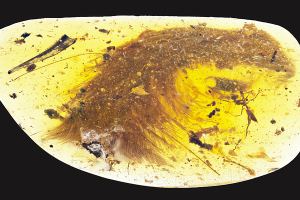
Ryan McKellar/Royal Saskatchewan Museum
of itself behind. Today, ninety-nine million years later, that resin is a ball of amber preserving insects, bits of plants, and tail bones and feathers from that poor babe.
It sounds like science fiction: a 99-million-year-old, feathery dinosaur tail encased in amber. But the specimen is real, and it is helping scientists envision how feathers evolved… ‘It’s so unsurprising to find a dinosaur with feathers now,[see Wikipedia for more on that] it’s like predicting that a fossil mammal would have hair.’ csmonitor.com
While most fossils are distorted and flattened in sedimentary rock, amber preserves a three dimensional form, allowing scientists to see just how different dinosaur feathers were from modern birds’. The baby dinosaur’s feathers were not for flight – perhaps they insulated it for warmth. Perhaps feathers retained by adults were used for signaling or some other sort of display, or maybe feathers were molted several times during life and ended up looking more like the famous Archaeopteryx, which is even older.
Scientists continue to debate the relationships of feather barbs and barbules, but the baby’s tail provides evidence of more than feathers. From the bones, it seems to be a two-legged theropod.
One other tantalizing clue the team found in the amber was the chemical signature of ferrous iron in the thin carbon film where the animal’s soft tissues would have been. That form of iron comes from blood proteins. csmonitor.com
Sadly, DNA doesn’t persist from the age of dinosaurs. So we can’t expect a clone of this baby that left its tail in amber to grow up today.
Filed under: Neat Science News Tagged: baby dinosaur, fossil in amber, how feathers evolved, what dinosaur is the size of a sparrow








December 7, 2016
Viking Carpenter #poem #poetry #Viking
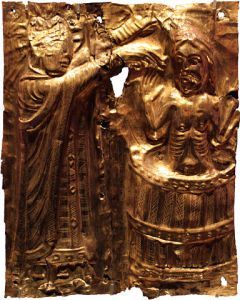
King Harald Bluetooth being baptized – wonder what tools were used to make a barrel?
What tools reside in your garage?
Hammer? File? Driver for screws?
A thousand years ago
What tools did Vikings use?
Tweezers you would recognize,
Pliers, piece of chain.
But what’s a spoon drill look like?
Draw plate for wire frame?
You’ve maybe never built a boat
Or your own home from wood,
The household things you need to fix
Less than a Viking could.
by Kate Rauner
Read more about this unusual discovery of a Viking carpenter’s toolbox at livescience.com
The archaeologists are still studying the heavily rusted objects, but they’ve already identified several sophisticated hand tools and other metal items, including a set of ‘spoon drills’ that were used to make holes in timber; what looks like a pair of tweezers or small pliers; a ‘clink nail’ used to fasten wooden planks together; four carefully crafted chain links attached to an iron ring; and a drawplate to make metal wires that may have been used in jewelry.
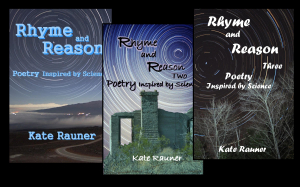 All my books, including collections of my science-inspired poetry, are available at Amazon, Barnes & Noble, iTunes, Kobo, and other major online retailers. You’ll also find paperbacks at Create Space and all major digital formats at Smashwords. Read one today.
All my books, including collections of my science-inspired poetry, are available at Amazon, Barnes & Noble, iTunes, Kobo, and other major online retailers. You’ll also find paperbacks at Create Space and all major digital formats at Smashwords. Read one today.
Filed under: Poetry Tagged: ancient iron hand tools, carpenter, draw plate, hammer, poem, poetry, spoon drill, Viking, wood working tools








December 3, 2016
Robots Automation and Jobs #robot #globalism Update
A new automated, flying ambulance completed its first solo flight, offering a potential solution for challenging search and rescue missions. livescience.com
Once survival is assured, there are three things human beings need to be happy: a sense of being
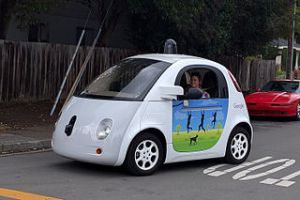
A self-driving car by Google
competent at something, be it a job or a vocation; enough freedom to feel autonomous; and a community to belong to. Many of us have used our jobs for one or two of these needs, all three if we’re lucky. Then we go home to suburbs or apartments where we don’t know our neighbors.
But what will happen when the robots arrive? American politicians promise to bring back manufacturing jobs, but automation is as much to blame as globalization for the loss. Now robots, in the form of self-driving vehicles, threaten to destroy one of our largest occupations: driving. Especially high school educated men rely on driving for employment, and commercial vehicles are likely to be the first to go robotic.
But many white collar jobs are endangered too. Law is one such profession where algorithms and analytics are replacing well-paid professionals.
What will we all do with ourselves? Governments can, perhaps, tax those lucky enough to generate the GDP so the rest of us don’t starve, but what about competence, autonomy, and community? Are we being freed or destroyed?
UPDATE: The story of automation gets bigger. Later the same day I posted this piece, I read about Amazon testing a brick-and-mortar convenience store without checkouts or cashiers.
Shoppers walking into the store call up the Amazon Go app and hold their smartphone to a scanner as they would at an airport security line. That opens a gate. Then they just pick any combination of products and walk out. Amazon charges them after they leave the store….
The Bureau of Labor Statistics says that cashiers are the second-largest occupation, with 3.5 million employed in the U.S. seattletimes.com
In my futurism book Glitch a character checks out of a grocery store by pushing his cart through an arch. I got the “no cashier” right but I’m already behind the times.
As the song says, times, they are a-changing.
Filed under: Neat Science News Tagged: Amazon Go, cashiers, driverless cars vehicles, drivers, futurism, lost blue collar jobs, lost manufacturing jobs, lost white collar jobs, robots, robots replace people humans, self-driving cars vehicles








Robots Automation and Jobs #robot #globalism
A new automated, flying ambulance completed its first solo flight, offering a potential solution for challenging search and rescue missions. livescience.com
Once survival is assured, there are three things human beings need to be happy: a sense of being

A self-driving car by Google
competent at something, be it a job or a vocation; enough freedom to feel autonomous; and a community to belong to. Many of us have used our jobs for one or two of these needs, all three if we’re lucky. Then we go home to suburbs or apartments where we don’t know our neighbors.
But what will happen when the robots arrive? American politicians promise to bring back manufacturing jobs, but automation is as much to blame as globalization for the loss. Now robots, in the form of self-driving vehicles, threaten to destroy one of our largest occupations: driving. Especially high school educated men rely on driving for employment, and commercial vehicles are likely to be the first to go robotic.
But many white collar jobs are endangered too. Law is one such profession where algorithms and analytics are replacing well-paid professionals.
What will we all do with ourselves? Governments can, perhaps, tax those lucky enough to generate the GDP so the rest of us don’t starve, but what about competence, autonomy, and community? Are we being freed or destroyed?
Filed under: Neat Science News Tagged: driverless cars vehicles, futurism, lost blue collar jobs, lost manufacturing jobs, lost white collar jobs, robots, robots replace people humans, self-driving cars vehicles








November 30, 2016
Beauty in the Bone #Haiku #nature #Poem #poetry
Essence of the form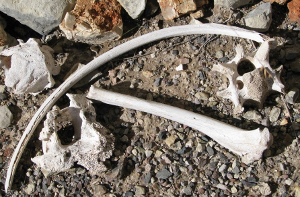
Buried under flesh and fur
Beauty of the bones
Here in the forests of New Mexico’s mountains, we all come across interesting bones. Everyone has a few on their porch.
All my books, including collections of my science-inspired poetry, are available at Amazon, Barnes & Noble, iTunes, Kobo, and other major online retailers. You’ll also find paperbacks at Create Space and all major digital formats at Smashwords. Read one today.
Filed under: Poetry Tagged: beauty in strange places, bones, haiku, nature, poem, poetry











